LACMA redesign to respect tar pits
September 26, 2013
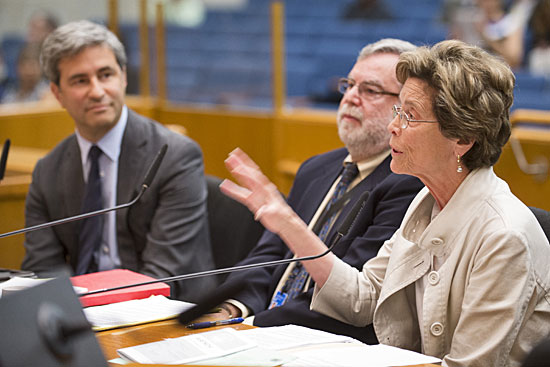
Jane Pisano of the Natural History Museum addresses supervisors, as LACMA's Michael Govan, far left, and James Gilson of NHM look on.
Leaders of the Los Angeles County Museum of Art and Natural History Museum are pledging to work together to make sure that a proposed new signature building on the LACMA campus doesn’t harm the landmark La Brea Tar Pits.
Preliminary plans for the new art gallery, to be designed by Pritzker Prize-winning architect Peter Zumthor, were unveiled this summer as part of LACMA’s “Presence of Past” exhibition, which showcased the architect’s concepts for transforming the museum campus.
The Swiss architect’s proposal calls for a largely transparent gallery—allowing passersby to view art through glass even without entering the museum—built in a curving shape reminiscent of the tar pits on the site.
But concerns about those tar pits quickly bubbled up after an early model and design were put on public display.
Officials of the Natural History Museum and its Page Museum, which oversees the Pleistocene era fossil-rich tar pits as an active scientific research site as well as a public attraction, were worried about the impact of the proposed LACMA construction.
On Tuesday, leaders of LACMA and the Natural History Museum came together to inform the Board of Supervisors that they are committed to working together to make sure the tar pits are protected.
“We can guarantee that there will not be a significant impact on the La Brea Tar Pits as we develop the plan,” Michael Govan, LACMA’s director and CEO, told the supervisors. He added that the design, now in its “earliest stages,” is meant not only to improve LACMA but also to create better access to the Page Museum and the tar pits that share the Hancock Park site, which he said would end up with an additional 1.2 acres of ground space. A cantilevered section of the design over the tar pit lake bed already is being altered in response to concerns, Govan said.
Jane Pisano, the Natural History Museum’s president and director, noted that LACMA’s plan is still “very preliminary and fluid, and if there is a negative impact on the tar pits, the design can and will be adjusted to protect them. This is something that Michael has said many times, and we take him at his word.”
However, she added, there are challenges ahead.
“Preliminary review of the plans for the building indicate that it would severely impact six of the nine tar pits in the park,” she said.
“So, early days, we know we have a lot of work to do. But we are assured that it is early days,” Pisano said. She said the early collaboration is essential to ensure that this “world-renowned destination” and unique scientific resource isn’t harmed.
“Ice Age fossils and micro fauna trapped in the tar below the surface provide invaluable information about life thousands of years ago, as well as possible clues for climate change and habitat in the future,” Pisano said.
Both parties said they are continuing to work with the county’s Chief Executive Office in the coming weeks to develop a memorandum of understanding to help them chart the course ahead. If the project is approved by LACMA’s board of trustees, the museum would undertake a two-year feasibility study. Construction would not begin until sometime after a new motion picture museum opens on the campus in 2017.
Govan said that the project presents LACMA with a unique opportunity to be a leader in reimagining how an encyclopedic museum can be structured.
“It has a plan that will be more accessible to the public than I think any that’s been designed anywhere in the world to date,” he said. “And that’s one of the exciting opportunities of a museum in a park.”
Doing nothing is not an option, he added, given the deteriorating state of the four buildings that would be replaced by the new structure.
Just bringing those buildings up to code would cost $317 million, he said. Early construction cost estimates for the new building range from $400 million to $450 million—costs that would be offset by significant energy savings from the building’s solar panels and by an increase in visitors to the museum, he said.
Supervisor Zev Yaroslavsky said that he was “not overly thrilled’ by the design at first, but has come to see it as a “stroke of genius.”
“This is a controversial plan architecturally. Any decent architectural plan is going to be controversial. If there’s no controversy, it isn’t worth the paper it’s written on.”
“Being able to build your project without doing any damage to the tar pits and the scientific research that continues to be done there is a no-brainer,” Yaroslavsky said. “There is room enough on that campus for both the tar pits and for the museum. And that’s the way it’s going to have to be.”

Architect Peter Zumthor's initial vision for LACMA shows a cantilever over tar pit lake bed. That element has since been altered. Photo/LACMA
Posted 9/25/13
Veterans come in on a high note
September 26, 2013
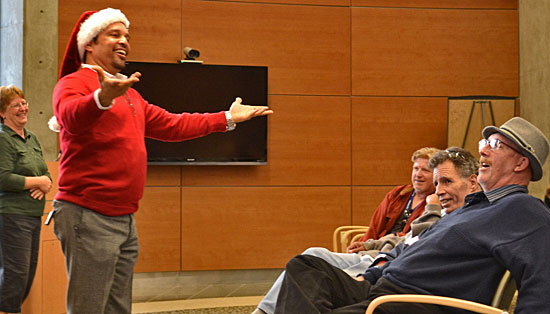
Performance tickets and holiday recitals are just part of the program as LA Opera reaches out to vets.
When “Carmen” struts her stuff on the Dorothy Chandler Pavilion stage at this Sunday’s matinee, there’ll be all the passion, lyricism and high drama you’d expect from Bizet’s operatic masterwork.
And, sitting in some of the best seats in the house, there’ll be a group of audience members you wouldn’t necessarily expect to find soaking up all that tempestuous romanticism: U.S. military veterans, growing into opera buffs thanks to an LA Opera program now entering its second year.
The veterans’ program is part of LA Opera’s Community Circle outreach, which makes thousands of tickets available each season to non-profit and community groups. Some pay a sharply discounted rate of $9 apiece for the tickets, which ordinarily go for about $105, while others, like veterans, get in free.
As a result, veterans from residences for retired military personnel in West L.A. and Long Beach have been getting a taste of the art form that some had known only from the movies—if at all.
“Last year, they saw four operas—Madame Butterfly, Tosca, The Flying Dutchman and Cinderella—and many of the vets were first-time opera-goers,” said Stacy Brightman, LA Opera’s director of education and community programs.
Millie Taylor, 89, who served as a Navy nurse during World War II and now lives at the Veterans Home of California in West Los Angeles, is relishing the prospect of seeing “Carmen,” conducted by Placido Domingo, no less.
“I love the music and the dancing and all the fiery action,” she said. “The costumes are just out of this world. I’m really looking forward to it.”
Taylor, who had never been to the opera before last year, reveled in the personal attention and great seats her group received—“just like paying customers.”
While some of the 16 West L.A. Veterans Home residents heading to the opera Sunday will be neophytes, Sadie Sonnenreich is not among them. The 99-year-old Army veteran says she’s been enjoying opera for half her life.
“It’s the music itself. I love the opera songs,” she said.
The opera’s outreach to vets isn’t limited to the performance tickets; speakers also present pre-opera talks at the residences to explain plot nuances and introduce some of the vocal talents they’ll be hearing. Opera artists also have performed holiday recitals for the veterans.
“People ask, why veterans? Well, who better than veterans?” LA Opera’s Brightman said. “We try to have each group come no more than once a year, but the veterans are the one we break our rule for. Their service to us all is so astonishing. It’s an honor to do anything we can for them.”

Veterans will see Patricia Bardon performing the title role in "Carmen" Robert Millard photo/LA Opera
Posted 9/26/13
Gate latching hits a roadblock
September 26, 2013

Elevated light rail stations, like in Culver City, are among the next targets for latching. Photo/L.A. Times
L.A.’s subway system has locked its gates and finally moved past an honor system that’s been in place for more than two decades. But it’s a different story at dozens of Metro light rail stations, which usually have stand-alone fare-card readers but no barriers to entry.
David Sutton, Metro’s deputy executive officer in charge of the gate-latching project, said that won’t change any time soon. Last week, in response to a July motion from several members of the Board of Directors, Sutton and his team released a report on the feasibility of installing lockable turnstiles on Phase 1 of Expo Line and at future stations throughout the expanding rail system.
“We’re not going to be able to lock them all,” Sutton said. “Some of the stations just don’t lend themselves to gates because of the space available and the cost.”
The primary reason is safety, said Rick Meade, who manages station construction for the agency. The National Fire Protection Association requires safe evacuation of platforms within 4 minutes in case of an emergency, as well as clearance to a “safe distance” within 6 minutes.
“As soon as you put gates on there, your exiting calculations are going to change because you have an obstruction that slows everything else down,” Meade said. Underground and aerial stations have space to accommodate enough gates for a swift exit, he said, but street-level stations usually do not. For those, increasing the size of platforms is often the only solution, a costly proposition that can encroach on traffic lanes or other property.
Some stations on the light rail system are already equipped with turnstiles, and their latching is slated for completion by February, Sutton said. On the Gold Line, the 5 out of 21 stations with turnstiles were latched earlier this month. Next up is the Blue Line, where 6 of 21 stations are scheduled to be latched in December, followed by all 14 stations of the elevated Green Line.
Along all Metro’s light rail routes, there currently are 41 stations where customers can enter without a barrier requiring payment, including the entire first phase of Expo Line. Sutton and his team examined the possibility of installing barriers at all non-gated light rail stations and have identified 13 for further analysis.
For Expo’s first phase, Metro estimates it would cost $3.1 million to add gates to three elevated stations, an investment the agency says could be recouped within 7 years because of increased fare collection. At the street-level stations, where there’s no room for gates, Metro is planning to add more stand-alone card validators at a cost of $173,000, plus $141,000 in annual operating expenses. Sutton said the non-gated card readers have been effective elsewhere in the system in reminding riders who want to comply with the rules to tap their fare cards.
“With gates and these kinds of things, it keeps honest people honest,” Sutton said.
Sutton said he plans to return to Metro’s Board of Directors in January with a full engineering analysis of what would be needed to install gates and additional card validators on Expo’s first phase, which goes from downtown to Culver City.
A similar gating scenario is being faced by Expo’s second phase, which will end in Santa Monica and is now under construction. At least two of the seven stations in that phase could not have locked gates, while four others are able to accommodate barriers and one other is being reviewed. For future rail projects that have yet to be designed or constructed, lockable gates will be required, Sutton said.
Meanwhile, on the Red and Purple lines, where gates have already been latched, preliminary data on fare collection for August is encouraging, showing a 22% increase in ticket machine sales over the same month last year—worth more than $614,000. Sutton said many free riders have left the system, opening more seats for paying customers.
The latched stations have also been a help to law enforcement, said Lieutenant Sergio Aloma, a transit services officer with the Los Angeles Sheriff’s Department, which is tasked with policing the system.
“Any time you can latch stations, it is better from a fare enforcement standpoint,” Aloma said. “I just wish we could latch them all.”
Aloma said latching even some gates allows officers to be deployed in larger numbers to non-gated locations. The increased visibility of law enforcement, he said, works as a deterrent to would-be fare evaders.
Aloma also said that, even at stations where gates are locked, dedicated scofflaws will find ways to beat the system by, for example, sneaking through access points for disabled people or jumping turnstiles. On the other hand, some riders may make honest mistakes such as forgetting to tap their fare cards when transferring lines as they try to figure out the new system.
“In some cases deputies have to use discretion and determine whether we need to take a customer-relations viewpoint or an enforcement viewpoint,” Aloma said. “This is still new and we want to educate folks on how to use the system.”
Posted 9/26/13
New law puts bike czar in rider’s seat
September 26, 2013

Senior bike coordinator Michelle Mowery has seen a sea change in attitudes about biking in Los Angeles.
You’ve got to hand it to Michelle Mowery. For two decades, she’s persevered, holding the job of “bicycle coordinator” in the nation’s most car crazy city. “A candle in the wind,” she calls herself. Make that a hard-blowing headwind.
But now, almost overnight, Mowery’s mandate has found a powerful constituency in City Hall and on the roads, giving her once-invisible position in the Los Angeles City Department of Transportation rising stature.
“We’ve put in more bike lanes in the past two years than during my entire career here,” she says. “We have a lot of work to do, but we’re getting stuff done.”
The latest achievement came this week, when Gov. Jerry Brown signed a law requiring California motorists to stay at least 3 feet away from cyclists when passing—a requirement already in effect in 22 other states. Four earlier versions of the measure had died because of various safety and liability concerns.
 When Mowery heard the news on Monday, she says one word came to mind: “Finally.” For years, she had championed such a law, alongside elected officials in Los Angeles and bicycle advocates statewide. She praises the measure as “a start and an acknowledgement that cyclists need that little bit of space to stay safe.” It will take effect next September.
When Mowery heard the news on Monday, she says one word came to mind: “Finally.” For years, she had championed such a law, alongside elected officials in Los Angeles and bicycle advocates statewide. She praises the measure as “a start and an acknowledgement that cyclists need that little bit of space to stay safe.” It will take effect next September.
According to the California Bicycle Coalition, which launched a “Give Me 3” campaign with Los Angeles advocates to give visibility to the issue, passing-from-behind collisions are the state’s leading cause of bicyclist fatalities. In fact, Mowery says, a galvanizing moment in the long effort to win passage of a buffer zone for cyclists came in 2006, after popular UC Santa Barbara triathlete Kendra Payne was struck and killed by an asphalt truck that tried to pass her on a sharply-curving road.
Mowery says existing California law simply states that drivers must keep a “safe distance” when passing cyclists, a subjective standard. Now, she says, law enforcement has been given a specific tool to cite motorists who invade a rider’s legal space. Even if police don’t make enforcement a top priority, the legislation’s educational value alone could save lives, says Mowery, a lifelong cyclist who’s now 54. She added that this is especially true in Los Angeles, where riders often need more room to dodge bad pavement conditions. “They’re not always able to ride in a straight line,” she says.
Mowery attributes the growing clout of cyclists to shifting demographics. She says that when baby-boomers like her learned to drive, the region’s freeways were new “and wide open. It was the land of opportunity for cars.” These days, however, the under-30-crowd is driving less, while increasing numbers of teenagers are deciding not to even get drivers licenses.
“They see people sitting in traffic and it doesn’t look like fun,” Mowery says.
Eric Bruins, planning and policy director of the Los Angeles County Bicycle Coalition, agrees, calling this “a golden era for bikes.” The new buffer-zone law, he says, is a “huge” step forward. “For us on the street, this is something we encounter every single day. Everybody just needs a better understanding of what it means to pass safely, and that’s what this law provides.”
Bruins credits Mowery with being a leading force behind the new law through her advocacy in Los Angeles and as a member of statewide cycling organizations. “I don’t think the bike community has understood what a quiet champion she has been…She’s been trying to get this [law] passed forever.”
Bruins says that, for years, Mowery had been a controversial figure, the public face of City Hall recalcitrance to demands for more bike friendly streets. But now, with the growing influence of Los Angeles cyclists, Bruins says, the city’s bike boss is riding high.
Says Bruins: “She is finally empowered to do her job.”
Posted 9/26/13
Betting on a shore thing
September 19, 2013
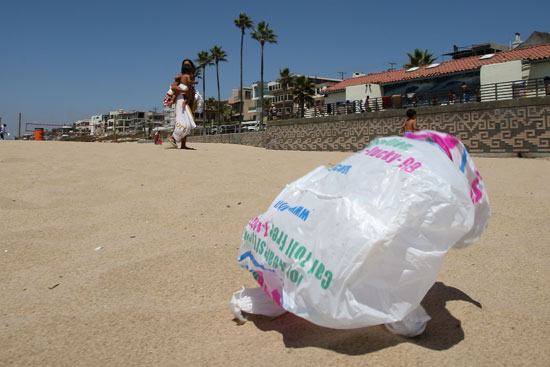
With plastic bag bans taking hold across the state, officials say our beaches are becoming beneficiaries.
At the end of each summer, the beach gets a close-up.
On the annual Coastal Cleanup Day, which occurs again on Saturday, thousands head to beaches and watersheds to pitch in during what’s billed as the largest volunteer event in the world. The junk they collect provides a troubling snapshot of how some of our bad habits can affect the environment.
During last year’s cleanup, a whopping 516,798 pounds of debris was collected statewide. The biggest offender was cigarette butts, accounting for 217,423 pounds, or 42 percent of the total. But plenty of other stuff was collected, too, including 94,182 pounds of food wrappers and containers, 43,783 pounds of plastic bags, 1,159 pounds of condoms, 1,187 pounds of six-pack holders and 508 pounds of syringes. You get the idea.
In L.A. County alone, 43,427 total pounds of debris was picked up last year, despite a volunteer turnout that was significantly reduced by triple-digit temperatures.
Still, the numbers offer a ray of hope. Eben Schwartz, who organizes the statewide volunteer push for the California Coastal Commission, said plastic bags, which take hundreds of years to decompose, are declining in jurisdictions that have enacted restrictions.
“In San Francisco, bags are way down the past couple of years,” Schwartz said.
Bans on single-use plastic bags started in the Bay Area around 2007 and are now banned throughout Alameda County. L.A. County banned plastic bags in 2010, but the ordinance only applied to county facilities and unincorporated areas, representing a small slice of the region’s total population. Other jurisdictions have since followed suit. In June, the City of Los Angeles got on board with an ordinance that will take effect next summer.
“On future cleanup days,” Schwartz predicted, “there’s going to be a whole lot less plastic bags in Los Angeles.”
Officials say that other government measures appear to be having an impact, too, including bans on Styrofoam containers and the installation of storm-drain screens to catch debris. The amount of trash collected statewide during Coastal Cleanup Day 2012 was just 12 pounds per person, down from 19 pounds in 2011, 15 pounds in 2010 and 17 pounds in 2009.
Over the past decade, catch basin screens have been installed in storm drains throughout L.A. County, said Kerjon Lee, spokesperson for the county’s Department of Public Works. The basins block trash from entering inland waterways and reaching the ocean.
Further downstream, Lee said, trash booms are deployed after rain storms to catch debris that has made it down flood channels and rivers. “They are good systems but they are end of the pipe systems,” Lee said of the booms. “It’s kind of a last, valiant effort to prevent debris from entering water bodies.”
Meanwhile, public health initiatives, such as banning smoking on the beach, have also had a positive impact on the on the environment, reducing trash on the sand and in the water, Lee said.
But not everything can be caught before it hits the water, and that’s where Coastal Cleanup Day comes in. The event began in Oregon in 1984. Nine years later, it had entered the Guinness Book of World Records as the “largest garbage collection.” The event has now spread to 35 states and nearly 100 countries. Here in L.A. County, both inland and at the coast, 11,000 volunteers will fan out on foot, on kayaks and even in wetsuits and scuba gear.
Liz Crosson, executive director of Los Angeles Waterkeeper, organizes a yearly scuba cleanup around “Hyperion Pipe,” which sends L.A.’s treated waste water miles out to sea. The structure that holds the pipe in place catches a lot of trash that enters the ocean. “I am amazed at what they pull out of there,” Crosson said. “They get pounds and pounds of plastic bags.”
Heal the Bay has been the lead organization for L.A. County’s Coastal Cleanup Day since 1990. Marissa Maggio is coordinating the event for the nonprofit environmental group.
“You can notice a difference; there’s definitely less debris at certain beaches,” said Maggio, who hopes to inspire people year round. “It would be great if every time you went to the beach, you bring a bucket and glove and pick up a little trash.”
Posted 9/19/13
A time to stay the course
September 19, 2013
After many years in office, I know how tempting it is for political bodies to jump into action when a problem is generating headlines or otherwise commanding public attention. But sometimes what sounds like a good idea may actually be counterproductive, falsely raising expectations at the precise moment when careful and dispassionate analysis should rule the day.
Such an issue surfaced this week at the Board of Supervisors, where my colleagues Mark Ridley-Thomas and Gloria Molina introduced a motion calling for the permanent creation of a Sheriff’s Department Oversight Commission, whose members would be appointed by the board.
They argued that ongoing investigations by the U.S. Justice Department and continuing allegations of brutality by deputies in the jails proved that a new level of civilian oversight was needed—one that a busy Board of Supervisors alone cannot provide. A vote is scheduled for October 8.
I certainly share the proponents’ desire to tighten the reins on the Sheriff’s Department, but let me tell you why I’ll be among the “no” votes.
As many of you may know, I’ve spent a good deal of my public life holding our region’s two biggest law enforcement agencies accountable for unconstitutional behavior, from the political spying and excessive force of the Los Angeles Police Department back in the 1980s to the escalating brutality inflicted on L.A. County jail inmates by sheriff’s deputies in more recent times. In fact, I championed the establishment of the Citizens Commission on Jail Violence, whose esteemed members last year proposed more than 60 reforms for the Sheriff’s Department’s jail operation.
The lynchpin of those widely-praised recommendations was the creation of an Office of Inspector General to provide rigorous, independent oversight of the department, reporting directly to the Board of Supervisors. We will soon review candidates to lead this essential watchdog agency.
The blue-ribbon panel—whose members included former federal judges, a big-city police chief and a prominent south Los Angeles pastor—specifically considered whether to recommend the creation of a permanent civilian commission, like the one now being proposed. The answer: no.
“The Commission believes that a fully empowered and integrated Office of Inspector General reporting to an engaged Board of Supervisors can provide the necessary independent oversight of the Department to ensure that it implements meaningful and lasting reforms,” the panelists wrote in their final report. The creation of another civilian commission, they said, “was not necessary.”
And should anyone question the Board of Supervisors’ level of engagement, Tuesday’s meeting alone should have offered an answer. Besides the proposal for a new oversight body, our day was packed with reports and debate on the status of the earlier jail commission’s recommendations, the decreasing number of serious use-of-force cases, and methods of coping with thousands of new inmates now serving sentences in the county lockup rather state prison because of sweeping changes to California law.
The strongest argument against a new oversight commission is simply that it would be powerless to force changes within the Sheriff’s Department. And, despite the suggestions of the measure’s backers, the Los Angeles Police Department does not provide us with a model for civilian governance.
The sheriff is publicly elected, making him directly accountable to voters every four years. Although the Board of Supervisors holds the purse strings, state law expressly gives the sheriff here and in counties across the state wide control over the operations of their departments. The LAPD chief, on the other hand, is politically-appointed and, under the city charter, reports directly to a five-member Board of Police Commissioners, which governs the department.
In their final report, the jail commission pointedly noted the difference between the two law enforcement agencies, saying that “a civilian jail commission would not have any legal authority over the Sheriff’s Department absent enabling [state] legislation.” The probability of getting such legislation is, at best, remote. In other words, the proposed commission would amount to little more than a soapbox for the panelists—and a disappointment for those of us committed to a top-to-bottom cultural change.
On Tuesday, my colleague, Don Knabe, called the proposal for a new commission “a bit premature.” I agree. The Citizens Commission on Jail Violence, staffed by some of L.A.’s brightest criminal justice minds, offered us a detailed roadmap to reform. That includes allowing an inspector general—whose authority Sheriff Lee Baca has said he will accept—to hold the department accountable through meaningful oversight.
We shouldn’t now be looking for shortcuts that, in the end, would divert us from our destination.
Posted 9/19/13
Love on the beach
September 18, 2013
From cigarette butts to lottery tickets, you never know what you’ll find at the International Coastal Cleanup. Eveline Bravo and Olga Ayala, for instance, found love.
It was 2007, and Bravo, brand new in her job as Heal the Bay’s beach programs manager, was recruiting site captains for the worldwide volunteer day, which this year takes place on Saturday.
Ayala was enlisted to help with the effort—the second year in a row that she had been called upon to round up volunteer trash-pickers.
At first, neither was particularly enamored of the other.
“The year before, and I kid you not, they had called me just one weekend prior,” Ayala remembers. “And I had dropped everything and done everything in my power to help them, but only about 15 people showed up.
“So this time, I was thinking ‘Maps, geographic zones, resources, highlighters—I’m gonna show them how you do this.’ And she was, like, ‘Uh, that sounds great, but actually, here’s how we’re going to do it.’ ”
“We clashed,” Bravo says, laughing. “I wanted to do my job my way.”
For months after that first meeting, their relationship remained frosty, even though Ayala—secretly impressed by the competence of the 10-years-younger Bravo—mustered hundreds of volunteers and broke a Heal the Bay record that year with the tonnage of trash they retrieved from their assigned cleanup site, a Panorama City park. (Cleanups in inland areas are a large part of the beach initiative because everything that gets into local waterways ends up in the ocean.)
With time, however, the ice melted. “She became like a challenge to me,” says Ayala. “I was like, ‘I’m nice, and you’re gonna like me.’ ” Bravo, meanwhile, says she began to do some soul searching.
“My New Year’s resolution that year had been to be nicer to people, and for some reason, as I made it, my thoughts went to her. So I sent her an email and a few months after that, we went out dancing. And somebody at the club asked me, ‘Are you two together?’ And after I said yes, I realized that she hadn’t been asking if we had come there together.
“So I looked at Olga and said, ‘I think we just told that girl that we’re together together. And she said, ‘Do you want to be?’ ”
The two became a couple, bound in part by the gifts that had drawn them to public service.
“I admire hardworking people who know what they’re doing,” says Ayala, who at the time she met Bravo was a field deputy to then-Los Angeles City Councilman Tony Cardenas. “And she was so hardworking, and straightforward, and kind, and beautiful—I fell in love.”
For Bravo, Ayala’s open heart was a revelation.
“As we became friends, I realized how pure and genuine she is—nothing bad ever comes out of her brain. I thought that people like that didn’t exist, but somebody can be mean or poor-spirited or a bad influence, and Olga just won’t see it. She never judges. Her heart is just genuinely into doing the right thing.”
In 2010, the bond deepened: Bravo was diagnosed with cancer and they discovered how much harder an ordeal like that could be for gay and lesbian couples, who lacked the legal protections that straight, married people took for granted. After her treatment, Bravo says, they made a pact to throw all their leftover energy and expertise into the marriage equality movement.
“We had to make all these hard decisions and go through surgery and get legal permission for Olga to be in the hospital with me,” says Bravo. “We decided that we needed our rights.”
So last month, a scant six weeks after the courts officially re-opened the doors for same-sex marriage in California, the two were wed in Calabasas by Ayala’s ex-boss Cardenas, who was elected to Congress, representing the San Fernando Valley’s 29th District, in 2012.
Now they live in mid-city Los Angeles with their cocker spaniel Sparky. And on Saturday, you’ll find them at this year’s Coastal Cleanup, picking up trash—together—at the Santa Monica Pier.
Posted 9/18/13
On kids’ side against sex traffickers
September 18, 2013
Michelle Guymon understands why people pass by the children on the boulevards, looking but not really seeing youthful lives shrouded in peril and despair.
For years, she did it herself.
“I’ve seen young girls on the side of the road,” said Guymon, who joined the county’s Probation Department in 1989. “There comes a time in your life when you don’t even pay attention to that anymore because you’re on the phone, you’re on your way to work, you’re focused on the street lights…You just drive by stuff.”
She’s not just driving by anymore. Three weeks ago, Guymon was named the first director of the county’s Domestic Minor Sex Trafficking Project. She’s determined to help the system—and the public—see the grim reality of underage girls, some as young as 10 years old, being victimized by the sex trade.
Guymon, 52, said her own awakening was a long time coming. For years, like others in the criminal justice system, she had taken a dim view of those girls by the side of the road.
“I had looked at these young women as teenage prostitutes, and this was just the crime they committed, like this girl over here committed a crime for robbery,” she says. “And I remember having judgments about them, that this was their fault, this was their choice.”
An unexpected assignment to a subcommittee on underage sex trafficking in 2010 shook her world view. At first, she was puzzled by the terminology being used, assuming that “trafficking” was something that just happened to kids from faraway countries.
When she attended the first meeting, she discovered that everything she thought she knew was wrong.
“It wasn’t until that moment when I realized, oh my gosh, you mean these kids are not teenage prostitutes? They’re not out doing this and making lots of money as a career choice?” she said. “They’re being what we’d consider sexually exploited. It was a defining moment for me.”
Instead of being victims of shadowy international sex trafficking rings, young girls here in Los Angeles, she found, are being sold into what some have called sexual slavery by local street gangs and other opportunistic homegrown criminals.
Now those girls had a champion, on the inside.
“She is probably one of the most committed, action-oriented and solution-focused persons that I have worked with in a very long time,” said Fesia Davenport, chief deputy director of the county’s Department of Children and Family Services, which is developing its own plan to attack the problem as part of the countywide effort. “She doesn’t have any egotistical skin in the game. She’s willing to take a good idea from anyone.”
Working with a colleague, Hania Cardenas, Guymon began dedicating herself to the issue—even though both she and Cardenas were also working demanding fulltime jobs within Probation.
In the three years since then, the county, with Probation at the forefront, has emerged as a leader in raising consciousness about underage girls being trafficked. Guymon estimates that her department alone currently has 435 sex trafficking victims under the age of 18 currently under its supervision, with some 3,000 more between the ages of 18 and 24.
Even as officials continue to gather data to get a better handle on the scope of the problem, initiatives—like a special “Girls’ Court” in Compton—have been launched to help surround young victims of sexual exploitation with supportive services and the kinds of human connections needed to break the bonds they’ve developed with their pimps.
Commissioner Catherine J. Pratt of the Girls’ Court said it is essential to have someone in Guymon’s position to keep the momentum going. “There’s a lot of system change that we need to do,” she said. “And she’s a wonderful person for it.”
Guymon’s small team—herself plus “a mighty three” probation officers—are focused on building that kind of trust. “These kids have my probation staff on speed dial, 24 hours a day, seven days a week,” she said.
Monthly training sessions at a hotel in Downey have now reached nearly 3,000 county employees and community activists, with a waiting list stretching through November.
The Board of Supervisors recently unanimously voted to urge the state to increase penalties for men who pay for sex with underage girls—including higher fines and a requirement that they register as sex offenders. Guymon testified in favor of the action, along with officials including District Attorney Jackie Lacey and Long Beach Police Chief Jim McDonnell, who said that local gangs’ involvement in sex trafficking is similar to their incursion into the narcotics trade in the late ‘70s and early ‘80s.
Ultimately, Guymon believes the state should decriminalize prostitution for girls under 18 years of age. But she acknowledges there’s a long way to go before the system is ready to deal with all the “unintended consequences” that might result.
In the meantime, she and a cross-departmental team are pushing forward to develop new protocols and practices to attack the problem.
“Once you know better, you have to do better,” she said. “You’ve gotta do something. You can’t ignore it. Our kids are counting on us.”
Probation Chief Jerry Powers said he named Guymon to her new post because the scope of her work on the problem had “mushroomed.”
“Even having been in the profession as long as I’ve been it, I would have never guessed it was as significant as it’s turned out to be,” Powers said. “Michelle’s work has helped us understand the complexity of the issue and the magnitude of it.”
“I think she’s awesome,” added Cardenas, her probation colleague and partner in the effort. “We always laugh about how we complement each other so well. She’s so outspoken. She likes to present. I’m a better writer. She kind of ended up being the face of it, which is her strength.”
The oldest of seven children, Guymon grew up in St. George, Utah, aspiring to play college basketball and ultimately to become a women’s basketball coach at the university level.
She went on to compete in college but found another, more satisfying, court to play on when she accepted an invitation to become the recreation director at a boys’ group home. Eventually, that work led her to a job with the Los Angeles County Probation Department. Looking back now, Guymon, who has a bachelor’s degree and master’s of social work from Cal State San Bernardino, knows she made the right move.
“Life threw me a curveball and I was just hooked,” she said. “I really am a kid junkie on some level. I feel like it’s where I’m supposed to be.”
Posted 9/18/13
Bringing the family together
September 12, 2013

A rendering of the San Fernando Valley Family Support center, which will provide a new, collaborative model for bringing government to the people.
Problems don’t always come one at a time.
When families need help for more than one reason, they often have to visit various locations and wait in lines while navigating the bureaucracies of multiple government agencies. But an innovative project in the San Fernando Valley will streamline that process by cutting the red tape in a new, state-of-the-art facility.
The San Fernando Valley Family Support Center, which breaks ground in Van Nuys on Saturday, Sept. 21, will bring seven Los Angeles County departments under one roof—in a building specially-designed to foster collaboration. Michael Samsing, who has worked on the project for the county Chief Executive Office since 1999, said the center will bring government to the people in a new way.
“It’s a one-stop location where families can access all the services that can help them,” Samsing said. Whether it’s food assistance, parenting skills or a child on probation, he said, “we’re going to get all the departments working together for the one client that comes to get services.”
This is the first time this kind of team effort has been planned from the ground up, Samsing said. Previously, departments have been co-located in a single building but didn’t fully integrate their operations, remaining separated by walls and layers of bureaucracy.
Samsing saw some of those barriers fall at meetings during which departments provided input on the project. “It was interesting to hear departments realize that they have common clients, that there are other services we can provide,” he said. “We all work in silos and this is really meant to blow that up.”
It all starts with the building—a five-story structure designed by HKS Architects, Inc. Thom Greving, the project designer, said the job reached the heart of what it means to be an architect. “People think we design buildings, but that’s secondary to what architecture really is—to craft experiences,” he said.
The design employs fewer walls and plenty of common areas, along with shared meeting rooms and group workstations in an open, campus-like environment. To create an uplifting work environment, Greving included a healthy dose of sunlight; 90% of employees will be within 30 feet of a window. The campus features walking paths, bike racks and plenty of greenery, including 380 new trees and a large, live oak as the centerpiece for the courtyard. Clients will enter a shared lobby, where they’ll check in through kiosks or greeters, Greving said.
The complex will be built on county-owned property on Van Nuys Boulevard, in an area that was found to have the highest concentration of social service cases in the valley, according to a study commissioned by the CEO in 2000. Two empty county facilities and a vacant bowling alley have been razed to make way for the new project. (The Mid-Valley Comprehensive Health Center, also located on the property, will continue to operate throughout construction and afterwards.)
The new building is targeted to achieve LEED Gold certification for environmental sustainability, but Greving said it might even make LEED Platinum, a much rarer distinction. Efficient heating and cooling systems will be installed in floors and bio-filtration gardens will serve as retention ponds to clean storm water runoff.
Each of the departments that will be housed there—Children and Family Services, Public Social Services, Child Support Services, Probation, Health Services, Mental Health and Public Health—will pay part of the $175.9 million price tag. Supervisor Zev Yaroslavsky, who has been involved in planning since the beginning, has also allocated $9.6 million to the project.
The support center also could provide much-needed economic revitalization in the area, said David Howard, who is managing its construction for the Department of Public Works. “With all the county employees and visitors,” he said, “there will be a lot of people seeking restaurants and shops.”
With construction underway, Samsing and another county CEO employee, Carlos Pineda, will focus on the operational details. Pineda is optimistic about the new environment, but he acknowledged that challenges remain. Technological incompatibilities, legal issues and requirements on how funds can be spent are all hurdles to confront. Pineda and Samsing hope their work will become a blueprint for future service, a more efficient model that will help families become aware of the full spectrum of assistance that county government can provide.
“Up until now we have been focused on the space,” Pineda said. “Now we’re figuring out how it will all work together.”
Posted 9/12/13




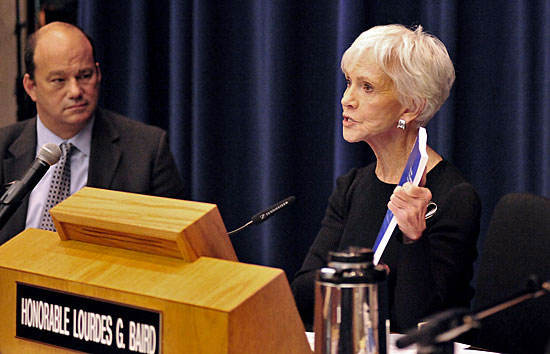


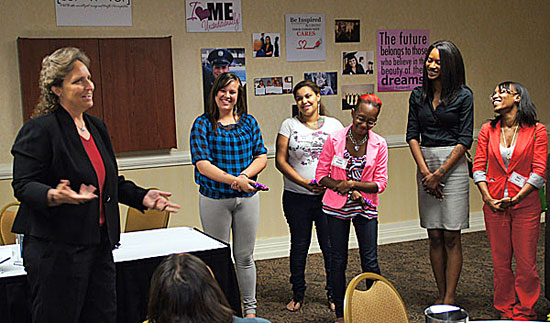
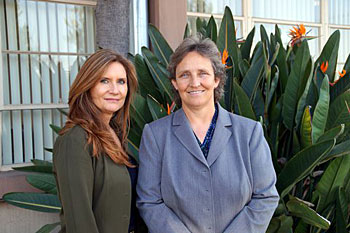
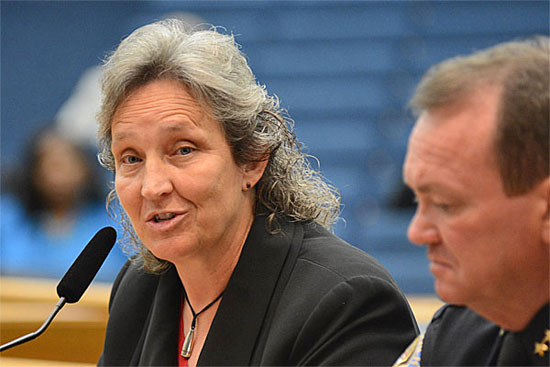





 Check for the latest closure information
Check for the latest closure information








